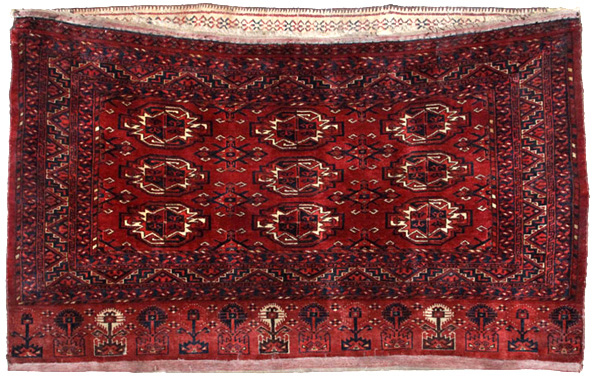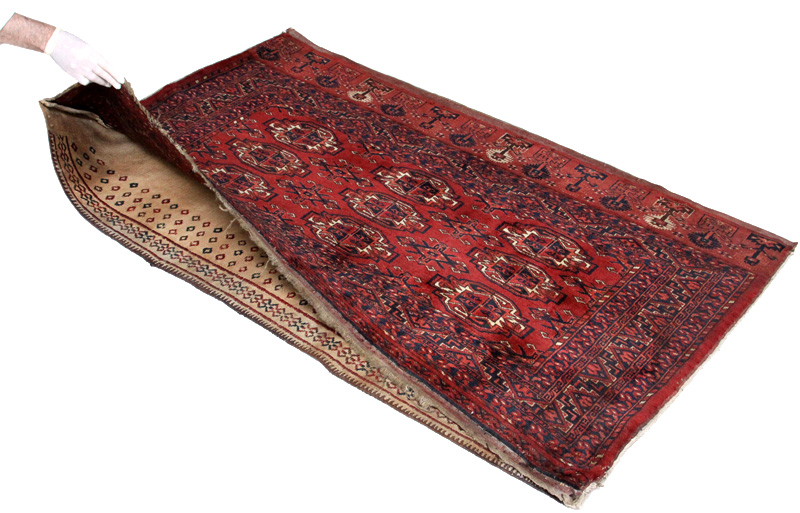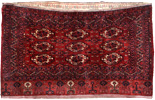< Back to Carpets
& Rugs
< Previous
Next >
Antique Turkmen Tent Bag - a Yomud Chuval
***
This is a rare 9 gol antique tent bag - a complete (face and back) Turkoman Yomud Chuval (also known as Juval, Juwal or Choval) with a very unusual and beautiful main border and skirt (elem) design. This type of flat storage tent bags were used in old times for keeping the entire suite of dowry weaving items of young Turkmen girls before their marriage. The richness of the knotting and the amazing pattern of the geometrical trees in the skirt part of the bag, are signs of a careful weaving approach, which are typical for bags that were used in the context of important Turkoman tribes weddings.
שק אכסון טורקמני עתיק, ג'ובל Chuval או חובל בשפת השבטים הנודדים במרחב שבין טורקמניסטן, פרס ואפגאניסטן של היום - רבים הסימנים לכך ששימש כאמצעי אכסון לפריטי הנדוניה של בת שבט טורקמני ממעמד גבוה, כנראה משבט הערבצ'י Arabatchi, בחתונתה עם בן שבט היומוד או היומוט, אחד מן השבטים החשובים באיזור טורקמניסטאן Yomud or Yomut. האריגה מיוחדת במינה באיכותה, ומציגה מוטיבים אמנותיים שאינם שכיחים בסוג זה של שקי אוהל tent bag או שקי אכסון storage bag. בולטים ביחודיותם ה"חצאית" בחלק התחתון של השק ובה דוגמה של שדרת עצים מעוצבים ביד אמן, ורצועות הגבול שמסביב למסגרת הגולים שמעידים על פיוז'ן סגנוני בין מסורות שני השבטים. מזל טוב!
The Chuval is a flat storage bag which was an important part of the tribal Yurt's "furniture" (Yurt is a circular domed tent which was very common in central Asia). The face of the Chuval was woven from the best quality wool, colored with vegetable based dyes and hues. The back of the Chuval was made of solid wool in pink-brown color with a humble yet sophisticated geometrical pattern, comprised of red and blue small trapezoid shapes. It seems that this wonderful bag reflects several tribal artistic styles:
1. The Yomut beautiful style and coloring of pile weaving, which is represented by its mature 9 gols pattern (gull, gul or gol means flower in Persian but to the Turkmen weaver, the term gol applied to the tribal ornaments placed in the field of the rug). The type of gol with the same pattern and emphasized white outlines is described by V.G. Moshkova as a classic Yomut Juwal gul AKA as Chuval gol. (See Note 2 below).
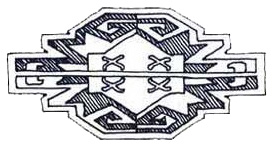
The Yomut Chuval gol as depicted by Valentina G. Moshkova in her book Carpets of the People of Central Asia.
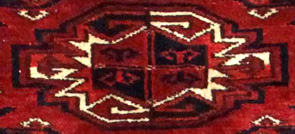
The Yomut Chuval gol in vivo.
2. The border of Chuval is a typical Yomut border - Jagged Zig-Zag border with "ram's horns" as demonstrated in the Yomud carpet (Jamut-Djafarbai) of the nineteenth century depicted in pages 114-115 of The Colour Treasury of ORIENTAL RUGS by Stefan A. Milhofer. (See Note 4 below)

The Yomut Chuval Jagged Zig-Zag border with "ram's horns".
3. The Arabachi - Ersari style, which is demonstrated by the unique stylized tree shrub-like (or cruciform) motif in the lower side of the rug in the additional wide border AKA the skirt part of the bag or the elem.

The unique stylized tree (or cruciform) pattern in the skirt part of the Yomud Chuval.
The unique stylized tree pattern is described by E. Gans-Ruedin in his legendary reference book Antique Oriental Carpets from the Seventeenth to the Early Twentieth Century as "a row of cruciform motifs - each cross rises from a plinth decorated with ram's horns, and the crosses themselves are crowned by smaller ram's horns". Note that the ram's horns motif appears also inside the four trapezium shapes which construct the center of the gol of this beautiful Juval.
Well, whether you call it a stylized tree or a cruciform there is no doubt that the row of these symbols is beautiful. BTW - E. Gans-Ruedin attributes this motif to the Saryk which may sound very reasonable since we know that the Arabatchi - Ersari assimilated with their stronger neighbors. In the Ersari carpet ornaments, more than in those of any other tribe, we can feel the fusion of the many alien elements to which they were exposed. This interesting fusion of different artistic styles and the fact that the Kilim of the inner side of the bag is embroidered, provide a strong indication that the bag was woven for a festive event of inter marriage between the two tribes, and that the design motifs of one tribe were incorporated into the rugs of the other. Here are some reminiscences of an authentic Yomud wedding, described by R.D. Parsons in his book Oriental Rugs, Volume 3, "The Carpets of Afghanistan":
The largest yurt bag, (always made in pairs) was the juwal. When migrating, these were hung one on either side of a camel, thus giving rise to the term 'camel bag'. Today however (the book was published in 1983), only seldom is a juwal actually used in this way, and then always in connection with wedding processions. Firmly implanted in the author's memory is a most picturesque scene that of a heavily veiled bride with all her vivid adornments, sitting on a platform perched on a camel dressed 'overall'. In one juwal were three young bridesmaids, while in the other were another bridesmaid and a matron of honor, all in their best clothes and sumptuously bedecked with silver jewelry...
Note 1: Yomud or Yomut? the Yomud is one of the major Turkoman tribes in the area between Iran and Turkmenistan. Veteran carpet dealers refer to the Yomud of Iran as Yomud and to the Yomud of Turkmenistan as Yomut. In general, the term Yomut is very often used as a convenient label rather than as the accurate identification of a historicall tribal group. Despite numerous attempts in the past, it has so far been impossible to work out a precise classification system. With some types of Yomut weaving, it is not even certain whether they are Yomut at all. This is made more difficult by an unusually broad range of shapes, design types and very different technical characteristics.
Note 2: Thomas Cole refers to Moshkova identification of the Chuval gol as follows: Though Moshkova describes this 'chuval gol' form to be a distinctly Yomud attribute, she is mistaken. The gol she refers to is seen below in Plate 14 is, among others, used by the Kizil Ayak as well as the Yomud. Cole also notes that this type of gol was borrowed from the Tekke although the Tekke used it mostly in their carpets and small rugs. See The Tribal Gol in Turkmen Carpets by V.G. Moshkova plate 13.
Note 3: Uwe Jourdan, Oriental Rugs: Volume 5 - Turkoman (1989 Example no 266 page 290) attributes a very similar rug to be a Kizil Ayak Chuval from the end of the 19th century. Jourdan cites Werner Loges who says that the principal motif used on most Kizil Ayak chuvals is the Chuval gul with the quartered center containing a stylized "ram's horns" motif. Loges also attributes the beautiful shrub-like motif found in the elem of this chuval to the Kizil Ayak / Ersari group.
Note 4: An antique Turkman Juwal presented in Turkotek by Jack Williams on 06-07-2006. The border of Jack's chuval is very similar to the border of the Yomud chuval presented here. Read more in an interesting Turkotek discussion about Turkmen chuvals with 140 posts.
Note 5: The Turkmen Arabatchi weavings traditions The Arabatchi tribe is one of the most obscure carpet-making tribes among the Turkmen nomads in Turkestan. Recent research has discovered more information about the tribe and its rugs which are still difficult to identify and date. Although the Arabatchi is an ancient tribe which probably inhabited the area of the Emirate of Bokhara, it is not known exactly what were the origins of the tribe and where it was firstly based. As with many other small all Turkoman and non-Turkmen tribes (such as the Baluch), the Arabatchi seem to have lost their identity during the 19th century by being compelled to join other larger and more powerful Turkmen neighboring tribes such as the Yomut and the Saryk. Because of their rarity, Arabarchi weavings are considered highly collectible rugs - extremely few weavings of age have been identified, most dated from the late 19th century. The Arabatchi rugs were woven in Persian knot. Typically, the rugs were made with part-cotton weft which gave the back a dotted brown and white appearance. The rugs' palettes are relatively dark and sometimes include fields of deep aubergine and brown colors. When weaving Chuvals, the Arabatchi usually employed a gul similar to that of the Tekke.
Note 6: Read more on the Archaic Yomut Chuval in the comprehensive online exhibition of Turkmen Weaving Culture and Trappings in the Weaving Art Museum site.
Size: 5' 2.2" x 3' 3.4" - 158 cm x
100 cm - 62.2 in x 39.4 in
Warp: Wool
Face thickness: 6 mm approx
Pile: Wool
Origin: Tribal groups in Turkmenistan / Afghanistan - Yomud
Weaving technique: Knotted and piled
hand weaving
Age: more than 100 years old (circa 1900).
Price: Call
References:
Oriental Rugs, A Complete Guide by Charles
W. Jacobsen - Antique Yomud Tent Bag from Afghanistan, Fig 31 in Page 71
- Turkoman Rugs. See also text regarding Yomud tent bags in page 164.
Techniques, Traditions & Designs by Andrew Middleton, ISBN 1 85732 634
2 - Antique Tekke Storage Bag
(Mafrash), Page 124. Rugs & Carpets.
Antique Oriental Carpets from the Seventeenth to the Early Twentieth Century by
E. Gans-Ruedin, - Saryk Juval, pages 412, 413 - A cruciform motif
decorated with ram's horns.
Kizil Ayak Chuval from the end of the 19th century - Uwe Jourdan, Oriental Rugs:
Volume 5 - Turkoman (1989) Example no 266 page 290.
Turkotek discussion about Turkmen chuvals - initiated by by Jack
Williams on 06-07-2006
Turkmen Rugs - Terminology, Transcription, Pronunciation, Spelling and
Nomenclature
Item: R1003/16 - Antique Turkmen Yomud / Ersari Chuval
© Dan Levy - Art Pane Home of Oriental Carpets and Rugs
< Back to Carpets
& Rugs
< Previous
Next >
